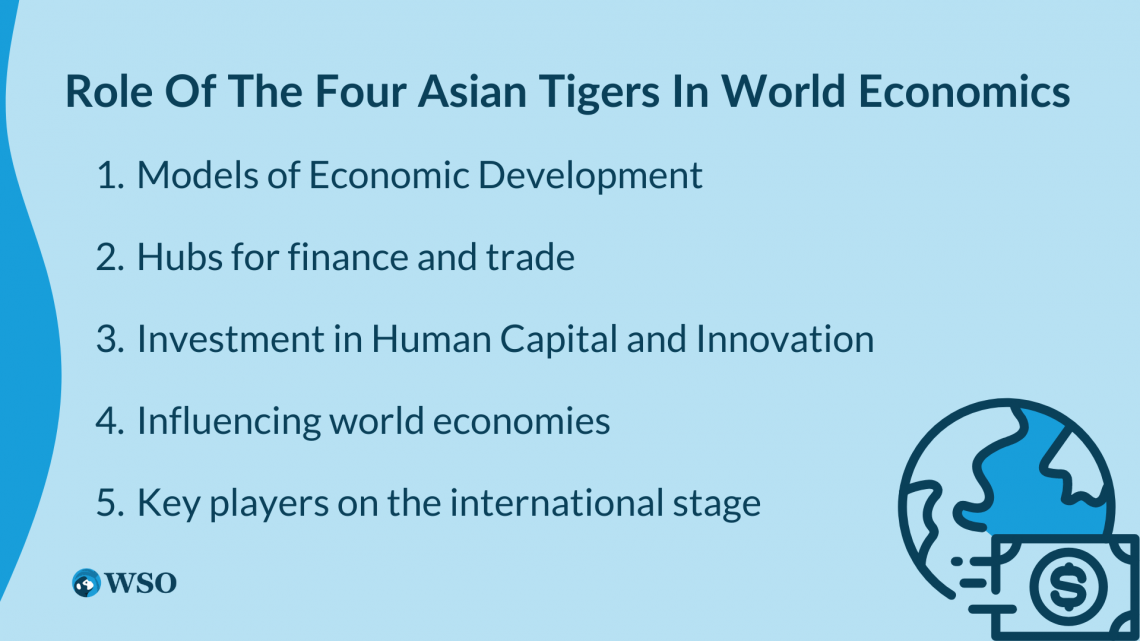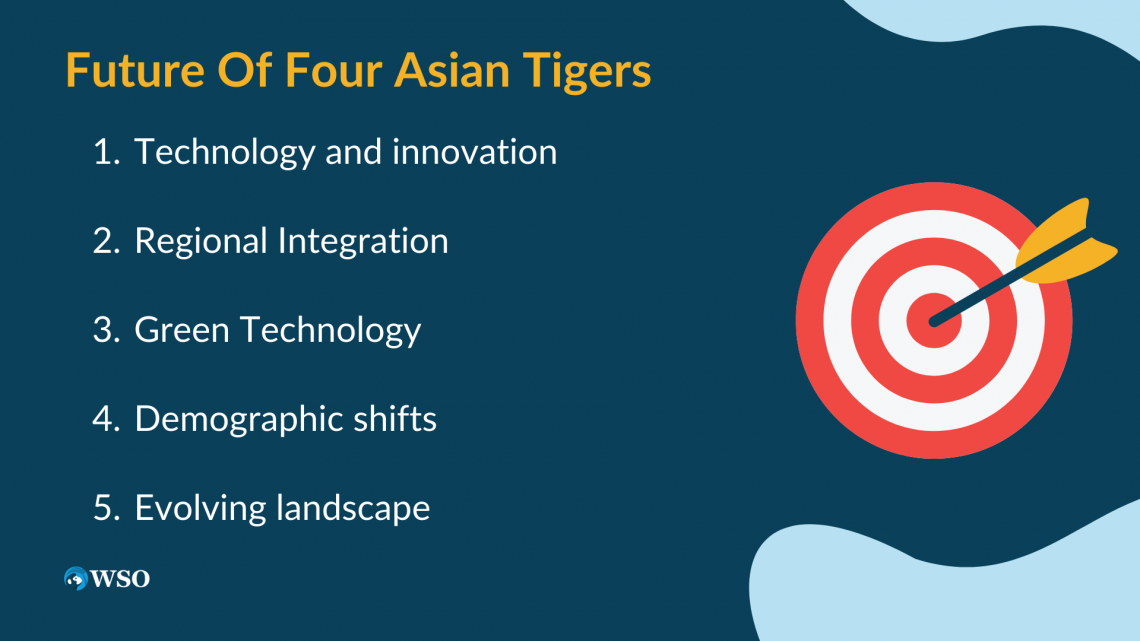Four Asian Tigers
The term “Four Asian Tigers” describes four highly developed economies in East Asia
What are the Four Asian Tigers?
The term "Four Asian Tigers" describes four highly developed economies in East Asia, namely Hong Kong, Singapore, South Korea, and Taiwan. These economies have achieved economic stability and prosperity through their robust financial sectors and strong rule of law.

Hong Kong transformed into a major financial center. Hong Kong's strategic location, advantageous taxation system, and business-friendly environment made it a popular gateway for trade and investment in Asia.
Singapore, a city-state at the southern tip of the Malay Peninsula, has emerged as a global economic powerhouse. A skilled workforce, effective governance, and efficient infrastructure enabled Singapore to develop finance, logistics, and manufacturing industries.
It drew multinational corporations and entrepreneurs as technological advancement and innovation centers.
South Korea's economy recovered strongly from the Korean War and is now a leader in advanced manufacturing. By prioritizing education and research, South Korea successfully cultivated globally competitive sectors such as electronics, automobiles, shipbuilding, and petrochemicals.

Companies like Samsung and Hyundai became household names worldwide, driving the country's economic growth.
Taiwan has leveraged technology to become industrialized, earning the nickname "Silicon Island." It has excelled in electronics and computer hardware production.
These four countries shared several common characteristics that contributed to their success. They all embraced export-oriented economies, focusing on manufacturing and international trade.

By leveraging their competitive advantages in areas like low-cost labor, technological innovation, and skilled workforces, these nations captured global market share and attracted foreign investment.
Furthermore, these countries invested heavily in education and human capital development. They understood the significance of a well-educated and skilled workforce for driving economic growth.
Their education systems emphasized science, technology, engineering, and mathematics, producing highly qualified professionals in abundance.
Key Takeaways
- The Four Asian Tigers, including Hong Kong, Singapore, South Korea, and Taiwan, achieved remarkable economic growth and rapid industrialization during the latter half of the 20th century.
- The Four Asian Tigers serve as economic development models, hubs for finance and trade, and leaders in human capital development and innovation.
- Their rapid growth created vast consumer markets, stimulated global trade, and made them sources of foreign direct investment.
- They can further capitalize on technology and innovation, strengthen regional integration, lead in green technologies, address demographic challenges, and navigate geopolitical complexities.
- The success of the Four Asian Tigers continues to inspire other developing nations with their resilience, adaptability, and effective governance.
Role Of The Four Asian Tigers In World Economics
The Four Asian Tigers - Hong Kong, Singapore, South Korea, and Taiwan have experienced rapid industrialization, technological progress, and impressive economic growth, positioning themselves as significant players on the international stage.

1. Models of Economic Development
These economies have served as economic development models for other nations. They have successfully transitioned from agrarian-based societies to high-income industrialized nations within a relatively short period.
Their success can be attributed to their emphasis on export-oriented industrialization, specializing in manufacturing goods for global markets. Through policies promoting exports and attracting foreign direct investment, the Asian Tigers have sustained high economic growth.
2. Hubs for finance and trade
The Four Asian Tigers have emerged as global hubs for finance and trade. Hong Kong and Singapore attracted most investors by giving them access to Asian markets.
These economies offer advanced financial services, robust regulatory frameworks, and political stability, making them attractive destinations for multinational corporations and investors looking to access the Asian market.
Note
Because of the nation's open and business-friendly environments have contributed to the growth of international trade and investment.
3. Investment in Human Capital and Innovation
The Asian Tigers have demonstrated the importance of investing in human capital and innovation. They have focused on developing highly skilled workforces through powerful education systems.
Additionally, they have encouraged a culture of innovation, leading to betterment in various sectors and technologies. This emphasis on human capital and innovation has contributed to their economic growth and competitiveness on the global stage.
4. Influencing world economies
The economic achievements of the Four Asian Tigers have had broader implications for the global economy. Their rapid growth and increasing affluence have created vast consumer markets, offering opportunities for multinational corporations to expand their customer base.
Additionally, their demand for raw materials and intermediate goods has stimulated global trade and benefited nations that export commodities.
Note
The Asian Tigers have also become major sources of foreign direct investment, investing in various sectors worldwide and driving economic growth in recipient countries.
5. Key players on the international stage
The Four Asian Tigers have profoundly impacted the world economy.
Their successful economic development models, financial prowess, investments in human capital and innovation, regional integration efforts, and global economic influence have positioned them as key players on the international stage.
These economies serve as examples of what can be achieved through sound economic policies, strategic investments, and a commitment to openness and international cooperation.
Note
As the global economy continues to evolve, the Asian Tigers will likely remain central to economic discussions and continue shaping the future of global prosperity.
Future Of Four Asian Tigers
Let's see the future expectations from the 4 Asian tigers.

1. Technology and innovation
One significant opportunity for the Asian Tigers lies in technology and innovation. They are already market leaders in the electronics, semiconductors, and information technology sectors.
Going forward, they can further capitalize on emerging technologies such as artificial intelligence, blockchain, and clean energy.
Note
By investing in research and development, developing entrepreneurship, and driving digital transformation, they can continue to enhance innovation and competitiveness and shape new industries that will shape the global markets.
2. Regional Integration
Strengthening regional integration is another opportunity for the Asian Tigers. As Asia becomes an economic powerhouse, deeper economic cooperation within the region becomes essential.
The Asian Tigers can play a pivotal role by leveraging their economic ties, trade networks, and financial expertise.
Note
They can drive regional economic growth and stability by deepening regional trade agreements, promoting connectivity and infrastructure development, and fostering collaboration in finance, technology, and sustainable development.
3. Green Technology
The Asian Tigers can become global leaders in sustainable development and green technologies. With the pressing challenges of climate change and environmental degradation, there is a growing demand for clean solutions.
These economies can utilize their technological capabilities, strong governance frameworks, and financial resources to invest in renewable energy, green infrastructure, and environmentally friendly practices.
By doing so, they can address environmental issues and position themselves as frontrunners in the emerging green economy.
4. Demographic shifts
The Asian Tigers also face challenges related to demographic shifts and aging populations. These pose concerns for labor supply, productivity, and social welfare systems.
Note
Policies promoting active aging, increased labor force participation, and attracting skilled foreign talent are necessary to overcome these challenges.
5. Evolving landscape
The evolving geopolitical landscape is another challenge. With complex political dynamics and regional tensions, the Asian Tigers must navigate risks, trade disputes, and potential disruptions to global supply chains.
Diversifying markets, strengthening regional partnerships, and proactive diplomacy are crucial to safeguarding economic interests and ensuring stability.
Leveraging technological capabilities, fostering regional integration, leading in sustainable development, and addressing demographic and geopolitical concerns will enable these economies to thrive and shape the global economy.
Their resilience, adaptability, and innovation position them well to seize opportunities and navigate the complexities of the evolving global landscape.
Summary
The Four Asian Tigers namely Hong Kong, Singapore, South Korea, and Taiwan – have been influential economies in driving East Asia and achieving remarkable growth and industrialization in the latter half of the 20th century.

They have served as successful development models for other emerging economies worldwide. Each of the Four Asian Tigers experienced significant economic transformation. The Four Asian Tigers embraced export-oriented economies, focusing on manufacturing and international trade.
These nations recognized the importance of education and human capital development in driving economic growth and innovation. They heavily invested in education systems that emphasized STEM fields, producing a pool of highly qualified professionals.
Government policies played a significant role in developing the Four Asian Tigers. They implemented proactive industrial policies that supported key industries, promoted innovation and research, and fostered a favorable business environment.
Note
Streamlined regulations and infrastructure development attracted foreign investment.
The Four Asian Tigers overcame challenges such as economic crises, global competition, and evolving market dynamics. Through resilience, adaptability, and effective governance, they managed to sustain their growth trajectories.
Today, the Four Asian Tigers continue to be vibrant and dynamic economies. Their industries have diversified into services, finance, technology, and knowledge-based sectors. The success of the Four Asian Tigers serves as an inspiration for other developing nations.









or Want to Sign up with your social account?